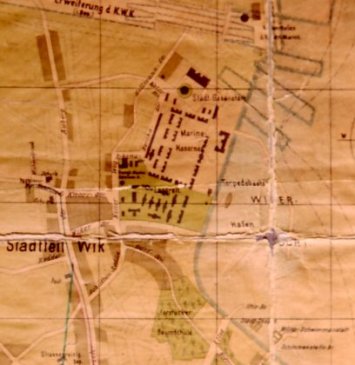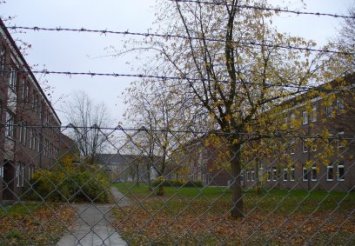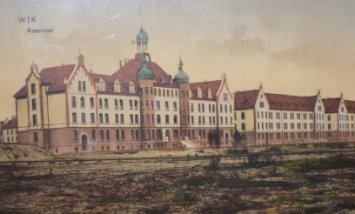Homepage Renate and Klaus Kuhl - Sailors' revolt in Kiel
Virtual Sightseeing Tour "Kiel Mutiny" Nov. 1918
[01] [02] [03] [04] [05] [06] [07] [08] [09] [10] [11] [12]
No. 05: Formation of the first soldiers' council at the barracks in Kiel-Wik, 4 November 1918
In the North of Kiel there is a large barracks compound, containing at that time the Ist Torpedo Division, the Ist Werft Division and the U-Boot-Division.
| Present day map | Former map |
|
Größere Kartenansicht | 
|
| Barracks compound in Kiel-Wik ca. 1920 (town archive Kiel) | |
| Present day view | Former view |
 |
 |
| View at the former drill ground from the Zeyestraße; Photo K. Kuhl, 2009 | Photo presented at the museum Warleberger Hof, Kiel, October 2007: 41 part of the imperial navy barracks blocks surrounding a large drill ground, 1905. |
Explanations of the events:
A detailed description can be found in Dirk Dähnhardt, "Revolution
in Kiel", Neumünster 1978, pages 70-72 (German)
Karl Artelt beschreibt die Vorgänge in einem Beitrag zu dem Band "Vorwärts und nicht vergessen - Erlebnisberichte aktiver Teilnehmer der Novemberrevolution 1918/1919" :
"The next morning [4 November 1918, Klaus
Kuhl] all troops in Kiel had to line up for inspection. ... After
the usual reports, the division commander, Kapitän zur See
Bartels, entered a specifically brought table and made a speech
.. He narrated yesterdays incidents, also said that the air was
charged with high voltage, but that a soldier had to abstain from
politics, because he could not comprehend politics. After he had
left the table, ... I didn't think twice and jumped up. I also
made a short speech and requested the marines to elect soldiers'
councils (Soldatenräte). Officers, trying to shoot me from
the table, were recklessly disarmed by marines' fists. Thereafter
we charged our arms arsenals and elected soldiers' councils in
all companies. I was elected chairman of the soldiers' council.
Shortly after we received a note, that I should see the Gouverneur
immediately. We got a car clear, fetched a huge red flag from
a torpedo boat, which was larger than the car and prepared for
the departure."
In summer 2010 we received a so far unpublished manuscript, written by Alfred Schwabe (see contemporary witnesses). he describes the events in Kiel-Wik, in which he took part directly:
"On the morning of 5 November [judging from the description, it is more likely 4 Nov., KK] our course, 40 petty officers and 10 upper sailors, received pistols and ammunition. We marched to the shipyard division (Werft-Division) in Kiel - Wik. ... We marched diagonally across the drill ground. At the right corner at the port 200–150 sailors had gathered for a meeting. We were led into the gym. A young lieutenant was in command and made a speech. Heroism and loyalty to the officers, fight against the mutineers was the content. ... For some minutes it was silent as in a church. Suddenly, a roar from far away, but it came nearer and nearer. "Attention, attention! Load pistols and lock them!" Between the upper sailors there was a whisper: "We do not shoot, we do not shoot." Turn right! March! Out of the gym!" We upper sailoers were at the end of the group and thus next to the attacking and partly armed sailors. They were those who had held the meeting on the drill ground. About 10 meters in front of the crowd there were two sailors who shouted to us: 'Comrades throw away your weapons, or come with your weapons to us, do not shoot at your comrades. Down with the war! Down with war dreamers!' 'Attention, attention! Fire!' our lieutenant shouted. A number of shots were fired, but I have not seen anyone being hit. I was not a moment undecided; we already pulled the others to our side. 'Let's get over, shit on the war!' Some of the petty officers joined in. There were shots again from our left wing of the petty officers and the lieutenant; because two defected petty officers were hit and were carried away. But the lieutenant suddenly disappeared from the scene without a trace and has never again in Kiel crossed our bow. We, the reinforced group, were running now to the barracks blocks, calling our slogans to the sailors and requesting them to follow us. Many joined in, some remained passive. There were actually very few officers there, and those present have been partly with kindness, and partly by force, been 'unrigged', i.e. had their epaulettes and the cockades removed. And so it went through about 15 blocks, the group grew bigger and bigger. Unfortunately, however, there were already robbers at work, since out of the closets and magazines plunged stuffed duffel bags from the upper floors and were dragged away and turned into money. But did not bother us at the moment. We stormed on. After all the barracks were combed through, we hurried to the pier. Two torpedo boats were prompted by gunfire and shouts to the hoist the red flag. Those were the first ships, which in Kiel hoisted the red flag on their masts. Unfortunately I forgot the ship numbers. Many boats followed; pinnaces went with a red flag at the stern to the 'thick coffers' and asked them to to join us. Full boats brought more and more revolutionary troops ashore. My barracks ship, the oldest 'coffer' of the navy SMS "Mars" (side panels made of wood) - it had fought against the Danes in 1866 - resisted for a long time. Two red sailors with a white flag were sent to negotiate, and managed that impressively the battle flag was removed and the red flag went up the mast. Large groups of sailors marched through the streets of Kiel and there was a systematic disarmament of the officers. The 'unrigging' was a real pleasure for some sailors, they could take revenge for drill and humiliation."
The virtual sightseeing tour at a glance:
- Holtenau viaduct and locks >>
- Large drillground (Großer Exerzierplatz) >>
- Karlstraße / Langer Segen >>
- Torpedo workshop Friedrichsort, Germania shipyard Kiel-Gaarden >>
- Barracks (Kasernen) in Kiel-Wik >>
- Marinestation Ostsee >>
- Arrestanstalt (military prison >>
- Trade union house (Gewerkschaftshaus) >>
- Town hall (Rathaus) >>
- "Schloßhof" >>
- Station (Bahnhof) >>
- Graves of the killed revolutionaries and soldiers >>
Real, guided tours on this subject are offered by:
- Geo-Step-by-Step >>
- Ernst Mühlenbrink, via Society for Kiel's Town History
(Gesellschaft für Kieler Stadtgeschichte) >>
- AKENS, Asche Arbeitskreis >>
Last modified: 13 Nov. 2011
| Sailors' Revolt / Kiel Mutiny November 1918 - here you'll find the following further information:
|
